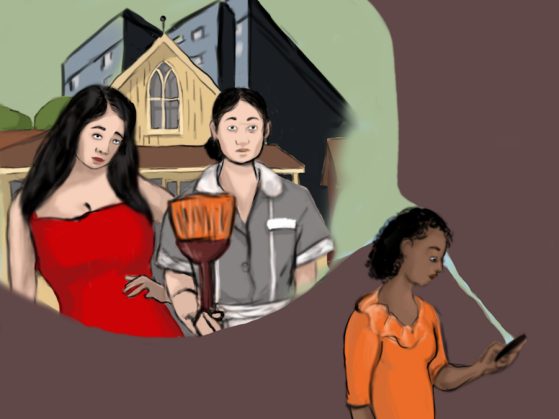- About
- News
- Events
- Initiatives
- Anti-Racism Collaborative
- Change Agents Shaping Campus Diversity and Equity (CASCaDE)
- Diversity Scholars Network
- Inclusive History Project
- James S. Jackson Distinguished Career Award for Diversity Scholarship
- LSA Collegiate Fellowship Program
- University Diversity & Social Transformation Professorship
- Publications & Resources
- About
- News
- Events
- Initiatives
- Anti-Racism Collaborative
- Change Agents Shaping Campus Diversity and Equity (CASCaDE)
- Diversity Scholars Network
- Inclusive History Project
- James S. Jackson Distinguished Career Award for Diversity Scholarship
- LSA Collegiate Fellowship Program
- University Diversity & Social Transformation Professorship
- Publications & Resources

March–August 2018 Pop-Up Grant Recipients
March 1, 2018NCID event “Campus Inclusion and Free Expression” featured in the Michigan Daily
April 11, 2018Scholar Story: Jillian Báez
"It was fascinating the way in which people used media not just as a form of information or entertainment but to gauge their place within the nation."
by Kevin Calhoun
Why does representation in media matter so much? According to Jillian Báez, "It’s not just a form of entertainment, but this actually has a much deeper meaning for communities that have been marginalized and haven’t really seen themselves on screen."

Artist: Yazmon Ector (NCID Art & Design Intern)
Dr. Báez is an assistant professor of media culture at the College of Staten Island-CUNY. She is a media scholar who explores how people make sense of media with a critical focus on the the portrayal of race, gender, and class in media, especially in Latino media. Her current book, In Search of Belonging: Latinas, Media, and Citizenship, looks at how Latina media audiences make sense of images in both mainstream media and Spanish-language media in the US.
This interview has been edited for clarity and length.
What is the focus of your recent book?
My book looks at Latina media audiences and representations that were coming out of the early 2000s, all the way up until 2015. This is the moment where there's a lot more emphasis in mainstream media on targeting Latino audiences. If you look at the trade journals within the media industry, a lot of them are talking about what they call Hispanic buying power or Latino buying power. And really they're focusing on this demographic world of Latinos, not just that there's more in the US, but focusing on their disposable income and wanting to target them as a market. You can see a lot more money being put toward advertisements that are for Latinos. You can see this both in mainstream media and Spanish-language media. What I wanted to get a sense of was, how do Latino audiences actually make sense of that?
In the summer of 2005, I began the pilot study to gain a sense of how people are making sense of the mood of the market. However, I was finding that a lot of Latino audiences kept talking about these questions of citizenship. I don't mean citizenship just in terms of legal citizenship, like actually having documentation to say that you are a US citizen, but I mean this more in a symbolic, cultural sense. People feeling like they are American. That they belong to the nation. That they have a place here, and they're worthy of being citizens. I found that people were equating this interest in the Latino market as also being worthy of being citizens. I learned right away that this question of belonging was central to representation in a way that I had not necessarily anticipated when I started the project.
As I started to move along with the project, I was finding a lot of ambivalence there as well. People would use the images to kind of understand how others thought about them in society, especially those outside of the Latino community, and whether they were included or marginalized. It was fascinating the way in which people used media not just as a form of information or entertainment but to gauge their place within the nation.
I also found they have different relationships to mainstream media than they did to Spanish-language media. I would say that both were vexed relationships. With mainstream English-language media, many of them felt underrepresented outside of advertising. They were seeing themselves being sort of marketed to for different products and services, but in the realms of film and television, they felt like they weren't really visible. When visible, women were represented as overly sexual, as more sexual than most other women, particularly when compared to white women. They had a problematic relationship with Spanish-language media because they found it can also be very sexist, homophobic, and also in terms of race, particularly television, privileges whiteness. A lot of them stay tuned into Spanish-language television, but they did not necessarily see themselves represented in it.
While there is visibility in terms of representation, it’s not the kind of representation that they would necessarily like to see or reflect their experiences. At the same time, there’s the feeling of being invisible because their experiences were not represented. So people sort of negotiate, if you will, in order to take an image that perhaps is not a perfect representation, but it's the only one that you have available, so they make it work.
What prompted you to examine this topic?
My interest in the topic is partly personal, and then part of it is because I saw a gap in the literature. On a personal level, I felt these questions of representation were constantly coming up in my family. When I was growing up, the only representation that I ever saw of Puerto Ricans was the West Side Story. My parents would set my brothers and me in front of the television to watch West Side Story every time it aired. I have to say in the early years, I didn't understand the significance of it. While it was a flawed representation of Puerto Ricans, it was the only one available. Not until I was in high school that I really understood, why it was so important to my parents.
At the same time, I was getting the sense that one of the only way that people, who were not Puerto Rican, knew about Puerto Ricans was through that film, which caused my frustration with it. People were trying to figure out, "Are you a Maria, or are you an Anita?" The virginal character or the spitfire character. But that was the only lens through which they knew Puerto Ricans, especially anyone outside of New York City.
Why are we underrepresented? Why don't we see ourselves here? I carried those questions with me growing up in the 80s and coming of age in the 90s. Then in the mid-90s, there's Selena's death: Selena the Tejana singer. This is the first time that I'm starting to see people, who are not Latino, seeing anything in terms of Latino media culture. She gained this mainstream coverage, even People Magazine covers it. But there are more representations of Latinos than this. That’s when I started to have these questions about “how are we making sense of this?”
Now, I get to graduate school, and I find out that there is a growing field of people studying Latino-oriented media, but they're mostly looking at content. They're doing analysis of what the representation looked like, so what characters, what storylines, the different stereotypes coming up over and over again. In terms of news, what kinds of stories are covered, who are the sources, etc. But there are virtually no studies of how Latino audiences are making any sense of that. Even though the question of audience, in my discipline, is the central question. You've got to have people who are consuming media, and then doing something with it. Even if that's just in your brain or you're not taking action, it is having some kind of impact.
I started looking at Latina women in particular because that's what the industry was focusing on. Advertising focused on women in general since the 50s and 60s, but I was seeing that the trend was to focus on Latinas, as well. Some of this had to do with the fact that Latinas were becoming more educated than their male counterparts, so I started seeing things like Woman's Day for Latinas or Cosmopolitan for Latinas, in English or bilingual form.
What are the key takeaways of your work?
I think the most important thing is that media representation matters. It’s not just a question of whether or not media is supposed to entertain us. Media also teaches us about the world and reinforces the norms in our society. It can also shape, unfortunately, I think as we've learned more recently, our anxieties and fears.
For example, one of the things that communication research have found is that you're more likely to rely on media when you haven't encountered a group. If in your daily life, you were encountering other groups of people face-to-face, that first and foremost, will color how you view those people. However, let's say you live in a homogenous community, where you're not meeting other groups of people face-to-face. What ends up happening is you will rely on media representations because that is your only knowledge of those groups.
In addition, media has a much deeper meaning for communities that have been marginalized and haven't really seen themselves on screen. For some marginalized groups, they can really give people a sense of whether they feel like they're part of a larger community or not. That’s why so many people are talking about Black Panther now. It can bring people together, or it can marginalize them.
And I think that’s really the heart of my project. Because if those images are really problematic, inaccurate, or just very limited, it also leads to people of that marginalized group to feel the "burden of representation." Those one or two representations have to basically stand in for everybody in their community. Even though there are all sorts of people within a particular community — a diversity of people. Which is why, ideally you would want a lot of representation versus just one or two.
For all these reasons, media representations really matters.
Are you interested in Dr. Báez’s work? Visit her profile here.




